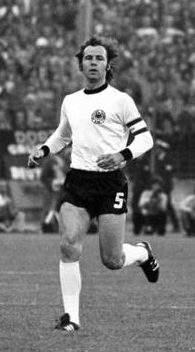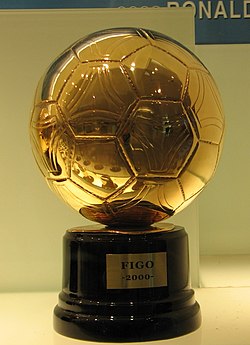Ballon d'Or
annual association football award From Wikipedia, the free encyclopedia
Remove ads
The Ballon d'Or is a special award given to a football player every single year. It has been given since 1956 by a French news magazine called France Football. From 2010 to 2015, it was combined with another award called FIFA World Player of the Year, and together they were known as the FIFA Ballon d'Or. However, in 2016, they separated again, and the award returned to its original name, the Ballon d'Or. FIFA also started giving its own separate award called The Best FIFA Men's Player.[2][3]
The Ballon d'Or was created by sports writers Gabriel Hanot and Jacques Ferran. It is given to the male player who is considered to have performed the best in the previous season. Football journalists used to do the voting for this award from 1956 to 2006.[4] At first, it was only given to players from Europe and was called the European Footballer of the Year award. But in 1995, it was expanded to include players from any part of the world who have played for European clubs.[5] After 2007, coaches and captains of national teams were also allowed to vote.[6] This made the award a global prize, and any professional football player from around the world became eligible to win it. In 2022, France Football changed some rules for the Ballon d'Or. They decided to give the award not for achievements in a calendar year but for a football season.[7] They also made it so that only countries in the top 100 of the FIFA World Ranking could vote for the award.[8] There is a different vote each year. It is for individual players to get recognised. Despite its popularity, critics have described the award as a "popularity contest", criticising its voting process and for systematically singling out an individual in a team sport.[9][10][11][12][13][14]
Remove ads
Winners
| |
This indicates the Ballon d'Or winning player also won the FIFA World Player of the Year or
The Best FIFA Men's Player award in the same year (available in 1991–2009 and from 2016) |
|---|




Remove ads
Notes
- Born in Argentina, Di Stéfano acquired Spanish citizenship in 1956 and went on to play for the Spanish national team.
- Kopa was signed by Reims from Real Madrid midway through 1959.
- Born in Argentina, Sívori acquired Italian citizenship in 1961 and went on to play for the Italy national team.
- Krankl was signed by Barcelona from Rapid Wien midway through 1978.
- Schuster was signed by Barcelona from 1. FC Köln midway through 1980.
- Boniek was signed by Juventus from Widzew Łódź midway through 1982.
- Simonsen was signed by Vejle BK from Charlton Athletic midway through 1983.
- Elkjær was signed by Hellas Verona from Lokeren midway through 1984.
- Gullit was signed by AC Milan from PSV Eindhoven midway through 1987.
- Weah was signed by AC Milan from Paris Saint-Germain midway through 1995.
- Klinsmann was signed by Bayern Munich from Tottenham Hotspur midway through 1995.
- Ronaldo was signed by Barcelona from PSV Eindhoven midway through 1996.
- Shearer was signed by Newcastle United from Blackburn Rovers midway through 1996.
- Shevchenko was signed by AC Milan from Dynamo Kyiv midway through 1999.
- Ronaldo was signed by Real Madrid from Inter Milan midway through 2002.
- Cristiano Ronaldo was signed by Real Madrid from Manchester United midway through 2009.
- Cristiano Ronaldo was signed by Juventus from Real Madrid midway through 2018.
- Messi was signed by Inter Miami from Paris Saint-Germain midway through 2023.
Remove ads
References
Wikiwand - on
Seamless Wikipedia browsing. On steroids.
Remove ads

